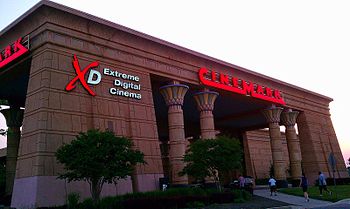How to save the movie theater business while lowering popcorn prices

English: The impressive Egyptian-themed entrance to the Cinemark Egyptian 24 movie theaters located at Arundel Mills Mall. (Photo credit: Wikipedia)
The cost of going to a first run movie is roughly the same as tickets to the nosebleed section of a professional sporting event – especially if you get popcorn and soda. The high cost of movie tickets is a better small talk conversation topic than the weather. Some people like rain, some like the heat, but everyone feels that movie tickets are too expensive.
For well under $1500, you can get a great home theater system, including the 65″ television. The subwoofer will shake the house, the floors aren’t sticky, and you can can pause it when the baby cries or you need to pee.
Those of us who pay extra to see a movie in the theaters do it because we love the experience. The smell of the popcorn, that moment when the lights dim, the bad red robot moving through the grass – often the movie itself diminishes the experience. Nobody wants to see the end of theaters. In fact, we want the ceremony of the theater experience to be greater than what it is.
Over the past 20 years, theaters have increased efforts to make the experience that is worth the premium price. Megaplexes have added stadium seats, cup holders, cuddle seats, and even tables with group seating in some hipster venues. The results have kept the industry alive, but they have also muted the nostalgic red curtain experience.
When discussing films, friends often provide opinions of a given movie by declaring it to be worth seeing in theaters, a rental, or wait for it to come on Netflix (or worse television). This is a confession that the theater experience still offers something significantly more special than all of the the amenities of home viewing.
The problem with the current movie theater business model is that it is too rigid. The most avid Adam Sandler fan will pay $20 (including the snack – maybe) to see Grown Ups 6 on opening day. After that week goes by, Sandler begins competing with Avengers 9. Avengers will likely be well attended, even on week nights, for two or three weeks while Grown Ups will barely fill 50 seats all day on the weekends.
The solution could be a tiered pricing model based on seats sold. Once a film fails to fill 50 percent of the seats, the price should drop by 20 percent. Opening night or weekends could also have premium pricing – which could include popcorn and soda. Most die hard Hunger Game fans would find a way to come up with $35 for an opening night ticket, even if they knew the price was going to drop to $20 two nights later and $10 two weeks later.
Why would someone pay full price if they knew the price would drop a few weeks later? Who knows, but they do. The video game and home video markets have been doing this for years. Theaters do it with second run films, but there should be something in between.
Imagine paying $20 to see a movie opening week, but then realizing that for $5 you could stay and watch an older film before it leaves the theaters. Normally, that $5 film would be empty, but by lowering the price, theaters could be filling seats. Selling 25 $5 tickets is better than 5 $10 tickets, right?
Every time I pay $30 for my wife and I to see a film that has been out for four weeks and there are only eight people in the theater, I think about how my tiered pricing model would have left me some money for a $10 popcorn and enriched the experience of watching the movie with an audience.